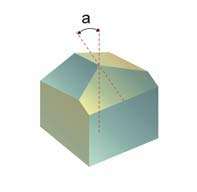Berkovich tip

A Berkovich tip is a type of nanoindenter tip used for testing the indentation hardness of a material. It is a three-sided pyramid which is geometrically self-similar. The popular Berkovich now has a very flat profile, with a total included angle of 142.3 degrees and a half angle of 65.27 degrees, measured from the axis to one of the pyramid flats. This Berkovich tip has the same projected area-to-depth ratio as a Vickers indenter. The original tip shape was invented by Russian scientist E.S. Berkovich in the USSR c. 1950, which has a half angle of 65.03 degrees.[1][2]
As it is three sided, it is easier to grind these tips to a sharp point and so is more readily employed for nanoindentation tests. It is typically used to measure bulk materials and films greater than 100 nanometres (3.9×10−6 in) thick.
References
- ↑ E.S. Berkovich, "Three-Faceted Diamond Pyramid for Studying Microhardness by Indentation," Zavodskaya Laboratoria, Vol. 13 #3, 1950, p 345-347 (in Russian).
- ↑ M.M. Khrushchov & E.S. Berkovich, "Methods of Determining the Hardness of Very Hard Materials: The Hardness of Diamond," Industrial Diamond Review, Vol. 11, Feb 1951, p 42-49 (in English).